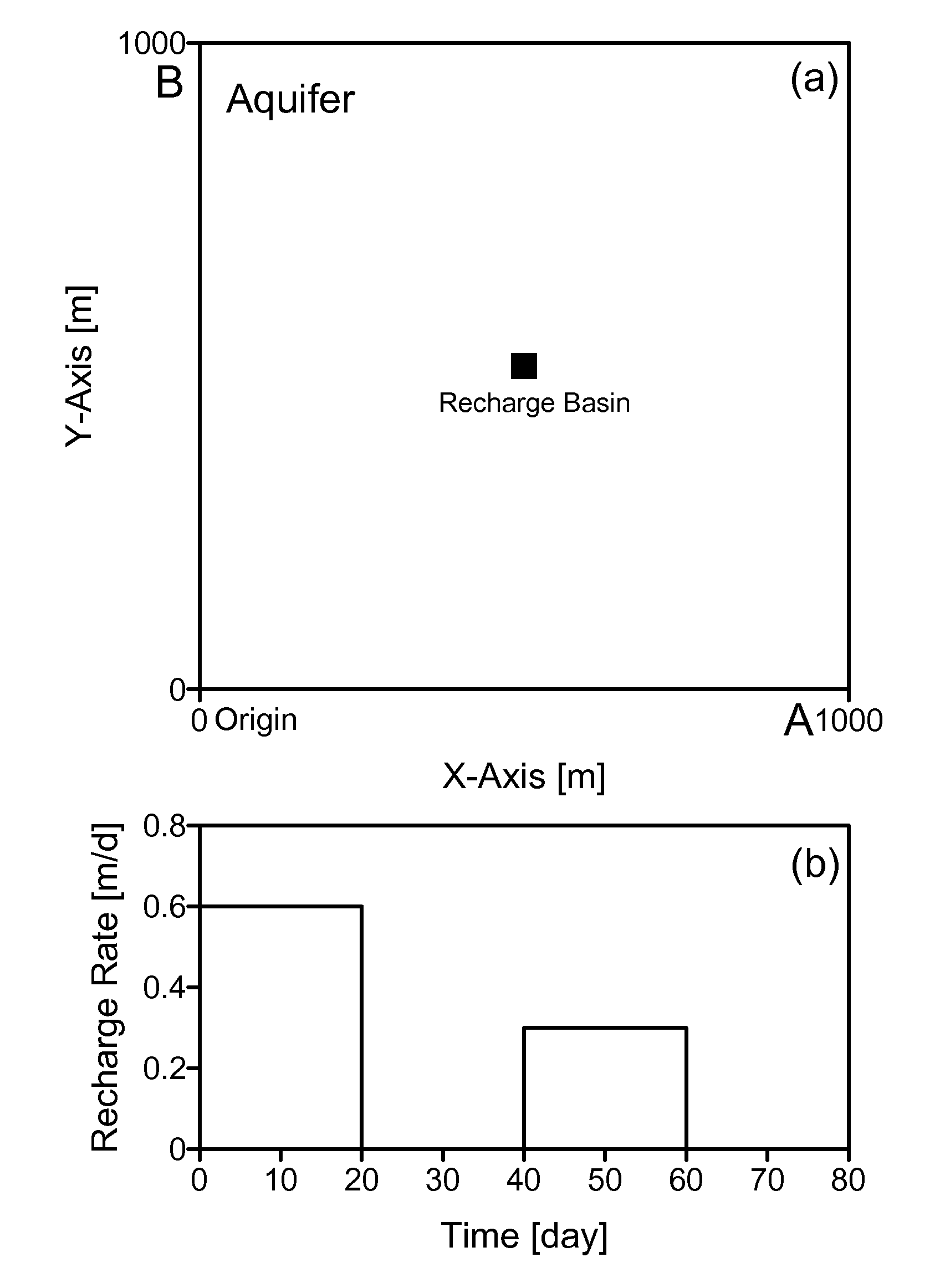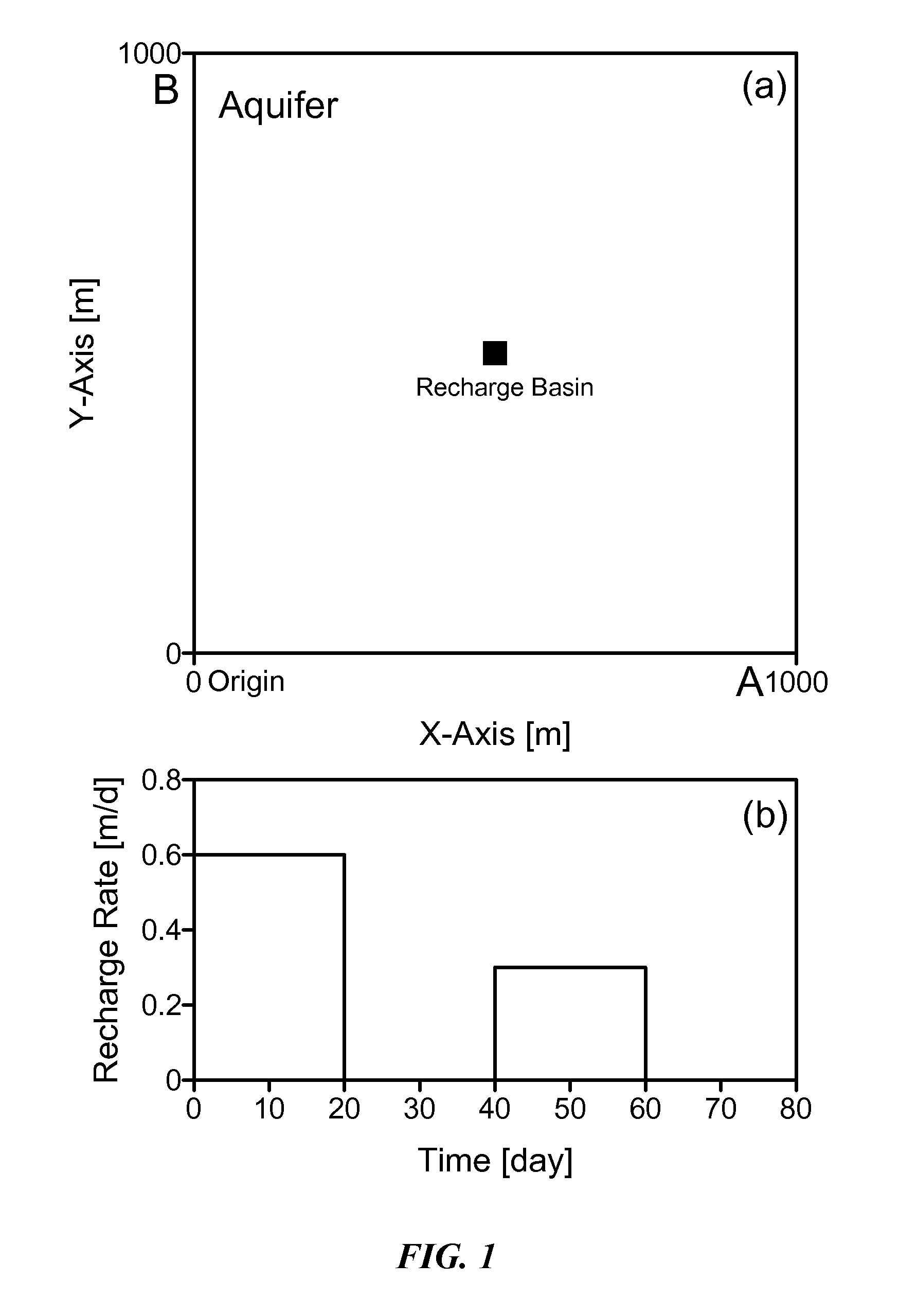Method of predicting the dynamic behavior of water table in an anisotropic unconfined aquifer having a general time-varying recharge rate from multiple rectangular recharge basins
- Summary
- Abstract
- Description
- Claims
- Application Information
AI Technical Summary
Benefits of technology
Problems solved by technology
Method used
Image
Examples
example-1
[0081]First example illustrates a case of water table variation in response to step-wise constant recharge rate from a rectangular basin located approximately at the center of an anisotropic unconfined aquifer. Prescribed head boundary conditions (Case-I) are used in this example. FIG. 1(a) shows a plain view of the aquifer and the recharge basin. FIG. 1(b) shows the variation of recharge rate with time. It indicates that two cycles of recharging are separated by a period of no recharge during 20th to 40th day. Other input parameters are:
Length of aquiferA1000 mWidth of aquiferB1000 mNumber of Fourier coefficientsm, n100Hydraulic conductivity in X directionKx4.0 m / dSpecific yieldS0.2Initial water table heighth010 mAnisotropy coefficientβ3.0Lower left corner of recharge basin(x1, y1)(480, 480)Upper right corner of recharge basin(x2, y2)(520, 520)
[0082]FIG. 2 presents contours of water table variation (in meter) with respect to the initial water table height at (a,b) 10th day, and (c,...
example-2
[0083]Second example includes three connected recharge basins (shaded region) to simulate a long canal and zero flux boundary conditions (Case-II). FIG. 3 (a) shows a plan view of the aquifer and recharge basins and FIG. 3 (b) illustrates the nature of recharge rate. The recharge rate is constructed by four sloping linear elements. Here, it is assumed that all the three recharge basins have the same nature of time varying recharge although the digitally implemented method supports different nature of recharge rates for each of these basins. Other input parameters are:
Length of aquiferA2000 mWidth of aquiferB2000 mNumber of Fourier coefficientsm, n100Hydraulic conductivity in X directionKx4.0 m / dSpecific yieldS0.2Initial water table heighth010 mAnisotropy coefficientβ3.0Lower left corner of recharge basin-1(x11, y11)(900, 1010)Upper right corner of recharge basin-1(x12, y12)(920, 2000)Lower left corner of recharge basin-2(x21, y21)(900, 990)Upper right corner of recharge basin-2(x22,...
example-3
[0085]In the above two examples recharge rate varied only with time. No spatial variations in the recharge rate were considered. Third example illustrates an application of the present invention in simulating spatially varying recharge rate. Here, a large recharge basin having spatially varying recharge rate is approximated by five rectangular basins as shown in FIG. 5. Basin 1 has a recharge rate of 0.4 m / d, basins 2 and 3 have recharge rate of 0.15 m / d, and basins 4 and 5 have recharge rate of 0.05 m / d. Constant recharge rate is considered only for simplicity but the present invention supports a more complicated case. Mixed boundary conditions are used for this case. Other input parameters are:
Length of aquiferA1000 mWidth of aquiferB1000 mNumber of Fourier coefficientsm, n100Hydraulic conductivityKx4.0 m / dSpecific yieldS0.2Initial water table heighth010 mAnisotropy coefficientβ3.0Lower left corner of recharge basin-1(x11, y11)(0, 0)Upper right corner of recharge basin-1(x12, y12)...
PUM
 Login to View More
Login to View More Abstract
Description
Claims
Application Information
 Login to View More
Login to View More - R&D
- Intellectual Property
- Life Sciences
- Materials
- Tech Scout
- Unparalleled Data Quality
- Higher Quality Content
- 60% Fewer Hallucinations
Browse by: Latest US Patents, China's latest patents, Technical Efficacy Thesaurus, Application Domain, Technology Topic, Popular Technical Reports.
© 2025 PatSnap. All rights reserved.Legal|Privacy policy|Modern Slavery Act Transparency Statement|Sitemap|About US| Contact US: help@patsnap.com



